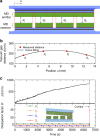Tailoring near-field thermal radiation between metallo-dielectric multilayers using coupled surface plasmon polaritons
- PMID: 30327494
- PMCID: PMC6191454
- DOI: 10.1038/s41467-018-06795-w
Tailoring near-field thermal radiation between metallo-dielectric multilayers using coupled surface plasmon polaritons
Abstract
Several experiments have shown a huge enhancement in thermal radiation over the blackbody limit when two objects are separated by nanoscale gaps. Although those measurements only demonstrated enhanced radiation between homogeneous materials, theoretical studies now focus on controlling the near-field radiation by tuning surface polaritons supported in nanomaterials. Here, we experimentally demonstrate near-field thermal radiation between metallo-dielectric multilayers at nanoscale gaps. Significant enhancement in heat transfer is achieved due to the coupling of surface plasmon polaritons (SPPs) supported at multiple metal-dielectric interfaces. This enables the metallo-dielectric multilayers at a 160-nm vacuum gap to have the same heat transfer rate as that between semi-infinite metal surfaces separated by only 75 nm. We also demonstrate that near-field thermal radiation can be readily tuned by modifying the resonance condition of coupled SPPs. This study will provide a new direction for exploiting surface-polariton-mediated near-field thermal radiation between planar structures.
Conflict of interest statement
The authors declare no competing interests.
Figures





References
-
- Modest Michael F. Radiative Heat Transfer. 2013. Inverse Radiative Heat Transfer; pp. 779–802.
-
- Polder D, Van Hove M. Theory of radiative heat transfer between closely spaced bodies. Phys. Rev. B. 1971;4:3303–3314. doi: 10.1103/PhysRevB.4.3303. - DOI
-
- Mulet JP, Joulain K, Carminati R, Greffet JJ. Enhanced radiative heat transfer at nanometric distances. Microsc. Thermophys. Eng. 2002;6:209–222. doi: 10.1080/10893950290053321. - DOI
-
- Chapuis PO, Volz S, Henkel C, Joulain K, Greffet JJ. Effects of spatial dispersion in near-field radiative heat transfer between two parallel metallic surfaces. Phys. Rev. B. 2008;77:035431. doi: 10.1103/PhysRevB.77.035431. - DOI
-
- Basu S, Lee BJ, Zhang ZM. Near-field radiation calculated with an improved dielectric function model for doped silicon. J. Heat. Transf. 2010;132:023302. doi: 10.1115/1.4000179. - DOI
Publication types
Grants and funding
LinkOut - more resources
Full Text Sources
Miscellaneous

